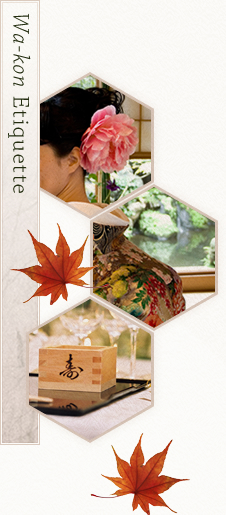
-
 Can a foreigner have a shinzen-shiki wedding?
Can a foreigner have a shinzen-shiki wedding? Is it possible to marry in a shinzen-shiki ceremony without wearing the shiromuku ?
Is it possible to marry in a shinzen-shiki ceremony without wearing the shiromuku ? Is the bride not allowed to eat the food?
Is the bride not allowed to eat the food? What is the tamagushi ?
What is the tamagushi ? Is there any difference in price between a jinzen-shiki and a chapel wedding?
Is there any difference in price between a jinzen-shiki and a chapel wedding? How many layers of kimono are worn?
How many layers of kimono are worn? How long does it take to put a kimono on?
How long does it take to put a kimono on? What if I need to go to the toilet?
What if I need to go to the toilet? Is the wig heavy?
Is the wig heavy? Does the wig ever slip?
Does the wig ever slip? Are there different types and fashions for montsuki hakama ?
Are there different types and fashions for montsuki hakama ? Are we supposed to empty the saké cup in sansan kudo ?
Are we supposed to empty the saké cup in sansan kudo ? Does the bridegroom also wear makeup?
Does the bridegroom also wear makeup? How long does the ceremony last, in all?
How long does the ceremony last, in all?
Can a foreigner have a shinzen-shiki wedding?
It is perfectly acceptable for non-Japanese to marry in a Shinto ceremony.
If a ceremony under a different religion is not acceptable, either to the couple or to their families, the couple can still marry wearing Japanese dress in a jinzen-shiki (non-religious) ceremony.
Is it possible to marry in a shinzen-shiki ceremony without wearing the shiromuku ?
Officially, the bride is supposed to wear shiromuku and kurohikisode , and the groom a montsuki hakama (crested kimono with pleated skirt).
The bride’s face and head are covered with the tsunokakushi headdress and watabōshi veil. This reflects the custom of the bride not showing her face to anyone but the groom until the ceremony is over. Recently, however, ceremonies are increasingly being held with the bride’s hair dressed in western style, and even in the Imperial family a shinzen-shiki ceremony has been held in western dress. As these examples show, there is no particular rule.
Is the bride not allowed to eat the food?
The normal courtesy is to listen politely while the guests of honor are making speeches, but the bride and groom may eat during other informal talking.
Some venues offer a service whereby the bridal assistants or other staff cut the food to make it easier for the bride to eat. So there should be no worries on that score.
What is the tamagushi ?
The tamagushi is a branch of the sacred sakaki tree with paper strips attached. It is offered to the Shinto deities during the shinzen-shiki ceremony.
Is there any difference in price between a jinzen-shiki and a chapel wedding?
The prices may differ from venue to venue, but the basic difference is that consumption tax is not added.
How many layers of kimono are worn?
The bride wears four layers at most, consisting of hadagi or jūban undergarments, kimono , and uchikake (full-length outer robe). Depending on the bride’s figure, toweling or other material may sometimes be used as padding.
How long does it take to put a kimono on?
The time needed for the whole costume including wig is normally around two to two and a half hours.
About one hour is enough for the groom.
What if I need to go to the toilet?
You are advised to go to the toilet before the costume fitting starts. Sometimes assistants and other staff will help you to get dressed, but it is basically possible for one person to do this alone.
Is the wig heavy?
Modern wigs are very light, and a lot of different colors are available. They are designed to be fitted without any discomfort.
Does the wig ever slip?
Wigs are adjusted in advance to fit the bride’s head. Each one is prepared individually, so there is no danger of the wig slipping.
Are there different types and fashions for montsuki hakama ?
Basically, the main types are the white haori (half-coat) and the black haori . Recently, these have started to become more colorful to match the bride’s costume, but they are not normally dictated by fashion.
Are we supposed to empty the saké cup in sansan kudo ?
In sansan kudo (the ritual threefold exchange of saké cups), the normal custom is merely to sip the saké twice, then to empty the cup on the third attempt. However, those who prefer not to drink alcohol may simply put the cup to their lips and pretend to drink.
Does the bridegroom also wear makeup?
Recently, it has become quite commonplace for men to attend to their appearance such as grooming eyebrows, so the groom will not usually need much attention. If the groom wishes, he may use foundation or other simple makeup.
How long does the ceremony last, in all?
It depends on the type of ceremony chosen, but is usually between around 20 and 40 minutes.
If we take part in the ceremony, do we have to wear Japanese dress?
There is no particular rule. Any formal wear will do.
If we choose Japanese dress, can it be hired?
Yes. The prices differ from venue to venue, but costumes can be rented and fitted for around 50,000 to 200,000 yen for women and 20,000 to 100,000 yen for men.
A Japanese wedding has the image of being very time-consuming. How long does the ceremony last, in all?
It depends on the type of ceremony chosen, but is usually between around 20 and 40 minutes.














